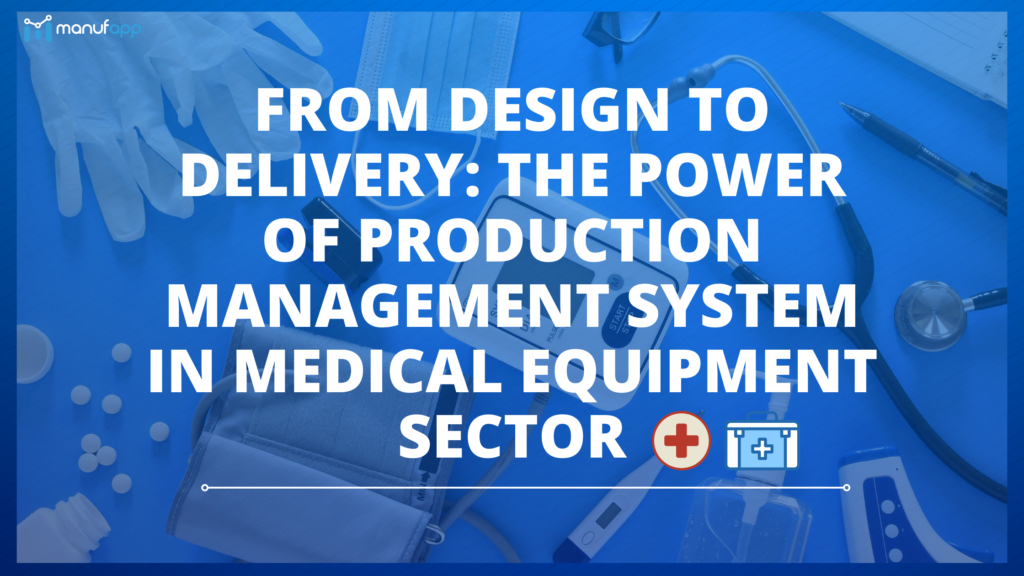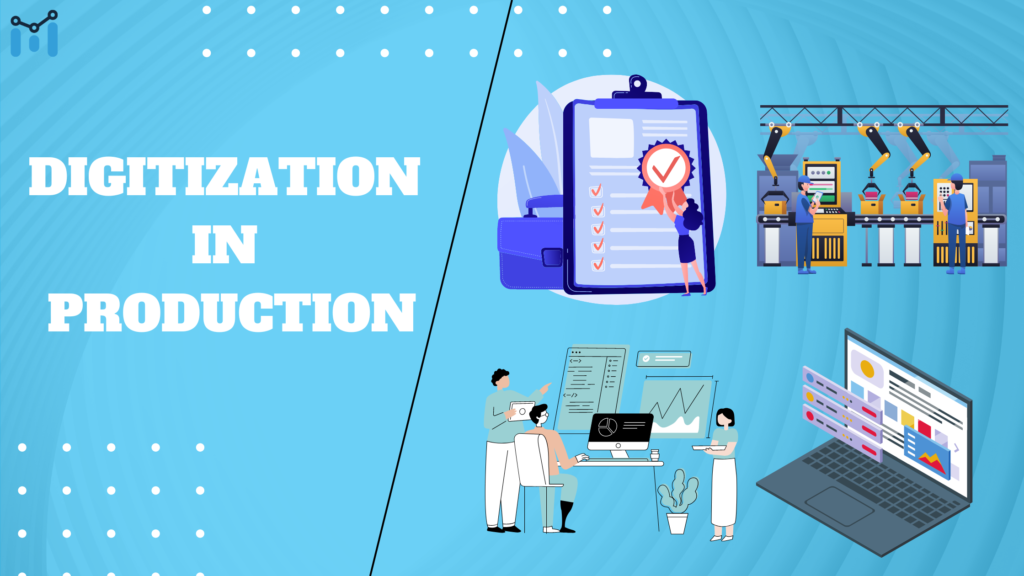In the intricate world of Medical Devices Manufacturing, precision, quality, and efficiency are paramount. The rapid advancements in medical technology call for seamless and reliable production processes to create devices that save lives and improve healthcare outcomes. Enter production management system (or Production Tracking Software) – a transformative solution that has reshaped how medical devices are conceptualized, developed, and manufactured. This blog explores the pivotal role of production management software in the realm of Medical Devices Manufacturing, unraveling its profound impact on streamlining operations, ensuring regulatory compliance, and ultimately, contributing to the delivery of cutting-edge medical solutions that revolutionize patient care.
Range of Products Manufactured by Medical Devices Industry
The Medical Equipment Industry manufactures a wide range of products that play a crucial role in healthcare and medical treatments. These products are designed to aid in diagnosis, monitoring, treatment, and patient care. Here are some examples of products manufactured by the Medical Equipment Industry:
Diagnostic Equipment: X-ray machines and computed tomography (CT) scanners, Magnetic resonance imaging (MRI) machines, Ultrasound machines, Electrocardiography (ECG) machines, Blood glucose monitors and Laboratory analyzers.
Monitoring Devices: Patient monitors (vital signs monitors), Pulse oximeters, Cardiac monitors, Holter monitors, Blood pressure monitors, Respiratory monitors
Therapeutic Equipment: Surgical instruments and tools, Infusion pumps (intravenous delivery), Dialysis machines, Ventilators and respiratory support devices, Defibrillators and Anesthesia machines.
Imaging Equipment: Medical imaging devices (ultrasound, MRI, CT, PET), Endoscopy and laparoscopy equipment, Ophthalmic imaging systems, Dental imaging equipment and Mammography machines.
Patient Care and Support: Hospital beds, Patient lifts and transfer devices, Mobility aids (wheelchairs, walkers, crutches) and Medical furniture and accessories.
Laboratory Equipment: Microscopes, Centrifuges, Autoclaves and sterilizers, Incubators and Laboratory refrigerators and freezers.
Dental Equipment: Dental chairs and units, Dental drills and instruments, Dental imaging systems (X-rays, intraoral cameras) and Dental lasers.
Rehabilitation and Physical Therapy Equipment: Physical therapy devices, Assistive devices for mobility and rehabilitation and Orthotic and prosthetic devices.
Surgical and Operating Room Equipment: Operating room tables and lights, Surgical instruments and tools, Electrosurgical devices and Laser systems for surgery.
Home Medical Equipment: Home oxygen therapy equipment, CPAP machines for sleep apnea. Home infusion devices and Medical alert systems
These are just a few examples of the diverse range of products manufactured by the Medical Equipment Industry. These products contribute significantly to medical care, diagnosis, treatment, and patient well-being across various healthcare settings.
The Medical Devices Industry in India has witnessed remarkable growth over the past few decades, driven by factors such as technological advancements, increasing healthcare awareness, government initiatives, and a rising demand for quality healthcare services. This growth has positioned India as a significant player in the global medical devices market. According to a report from the *MarketResearch, the medical devices market in India is expected to reach INR 4,358.64 Bn by FY 2027, expanding at a compound annual growth rate (CAGR) of ~41.93% during the FY 2023 – FY 2027 period.
How Production Management Software can benefit Medical Devices Industry
Production Management System offers a multitude of benefits to the Medical Devices Manufacturing industry, enhancing efficiency, quality, and regulatory compliance. Here are key points outlining how production management software can benefit the industry:
Enhanced Production Planning and Scheduling:
Optimize production schedules based on real-time data, demand, and resource availability.
Minimize bottlenecks, reduce idle time, and ensure efficient utilization of equipment and labor.
Regulatory Compliance Assurance:
Implement traceability and documentation features to ensure compliance with stringent industry regulations and quality standards (e.g., FDA, ISO).
Maintain detailed records for audits and regulatory submissions.
Quality Control and Assurance:
Integrate quality checks and inspections into the production process to ensure consistent product quality.
Detect defects early, reduce rework, and enhance overall product reliability.
Inventory Management Optimization:
Monitor and manage raw materials, components, and finished goods inventory levels.
Prevent stockouts, overstocking, and minimize carrying costs.
For more detailed analysis please read our blog on Role of technology in improving Production and Inventory Management that focuses on the topic within your needs.
Real-time Visibility and Reporting:
Gain real-time insights into production processes, performance, and KPIs.
Generate comprehensive reports for data-driven decision-making and continuous improvement.
Workflow Automation:
Automate manual tasks and workflows to reduce human errors and accelerate production cycles.
Streamline order processing, material requisition, and documentation management.
Demand Forecasting and Planning:
Utilize historical data and predictive analytics to forecast demand and plan production accordingly.
Minimize supply-demand imbalances and ensure timely deliveries.
Resource Allocation Optimization:
Allocate resources (labor, equipment, materials) efficiently based on production priorities and requirements.
Minimize production downtime and improve resource utilization.
Supplier Collaboration:
Collaborate with suppliers in real-time, ensuring timely delivery of quality materials and components.
Enhance transparency and communication along the supply chain.
Scalability and Adaptability:
Easily scale up or diversify production to meet changing market demands or introduce new product lines.
Flexibly adapt to market trends and customer preferences.
Risk Management:
Identify and mitigate potential production risks, such as supply chain disruptions or equipment failures.
Implement contingency plans and minimize production interruptions.
Continuous Improvement Initiatives:
Leverage data analytics to identify areas for process improvement and operational efficiency.
Implement lean manufacturing principles and drive ongoing optimization.
Integration with Other Systems:
Seamlessly integrate with other enterprise systems, such as ERP and CRM, for end-to-end business process optimization.
Time-to-Market Reduction:
Accelerate product development and time-to-market by streamlining production workflows.
Respond quickly to market demands and gain a competitive edge.
By harnessing the capabilities of production management software, the Medical Devices Manufacturing industry can elevate its manufacturing processes, uphold product quality, ensure compliance, and drive innovation in the creation of critical medical equipment that improves patient care and healthcare outcomes.
In addition to above information, would also like to have a look into our Blog on The Evolutionary Role of PMS in the Industrial Equipment Sector.
Points to consider while implementing Production Management System
Implementing production management system in the Medical Devices Manufacturing industry requires careful planning and execution. Here are key points that medical device manufacturers should consider during the implementation process:
Define Clear Objectives:
Clearly outline the goals and objectives of implementing the production management system.
Identify specific areas of improvement, such as production efficiency, quality control, or regulatory compliance.
Cross-Functional Collaboration:
Involve representatives from different departments (production, quality, regulatory, IT) in the planning and implementation process.
Ensure alignment of objectives and smooth communication between teams.
Vendor Selection:
Thoroughly evaluate potential software vendors based on their industry expertise, product features, and track record.
Choose a vendor that understands the unique needs and regulatory requirements of the medical devices sector.
Customization and Scalability:
Assess the software’s customization capabilities to tailor it to the specific workflows and processes of medical device manufacturing.
Ensure that the software can scale to accommodate future growth and changes in production volume.
Regulatory Compliance:
Ensure that the software aligns with industry regulations and standards, such as FDA regulations and ISO certifications.
Verify that the software supports traceability, documentation, and reporting required for compliance.
Data Security and Privacy:
Prioritize data security and protection of sensitive patient and production data.
Choose software with robust cybersecurity features and encryption protocols.
Change Management:
Develop a change management strategy to prepare employees for the transition to the new software.
Provide training and support to help users adapt to the changes.
Data Migration:
Plan for the migration of existing production data to the new software system.
Ensure data integrity and accuracy during the migration process.
Integration with Existing Systems:
Evaluate how the new software will integrate with other systems, such as ERP, CRM, and quality management systems.
Ensure seamless data exchange and communication between different software platforms.
User-Friendly Interface:
Choose software with an intuitive and user-friendly interface to facilitate ease of use and adoption.
Provide training to employees to maximize their proficiency with the software.
Testing and Pilot Phase:
Conduct thorough testing and validation of the software in a controlled environment before full deployment.
Consider implementing the software in a pilot area or production line to identify and address any issues.
Continuous Improvement:
Designate a team to monitor the software’s performance and gather feedback from users.
Continuously assess the software’s effectiveness and make necessary refinements.
Vendor Support and Updates:
Ensure that the software vendor offers comprehensive technical support and regular updates.
Maintain a strong relationship with the vendor for ongoing assistance and troubleshooting.
Return on Investment (ROI) Analysis:
Assess the expected ROI of the software implementation in terms of improved efficiency, reduced errors, and cost savings.
Measure the actual impact of the software over time to validate its benefits.
By addressing these points, medical device manufacturers can successfully implement production management software that enhances their manufacturing processes, supports regulatory compliance, and contributes to the production of high-quality and safe medical devices.
Summary
Through its multifaceted capabilities, this software has redefined the landscape, seamlessly orchestrating the complex symphony of design, production, and delivery that underpins the creation of life-saving medical devices. By optimizing processes, ensuring regulatory compliance, and fostering continuous improvement, production management software empowers manufacturers to elevate their craftsmanship and deliver devices of unmatched quality. As the industry evolves to meet the ever-growing demand for advanced medical technologies, production management software emerges as a cornerstone, empowering the pursuit of excellence, innovation, and, above all, the noble mission of enhancing healthcare for millions around the world. In this digital age of healing, production management software is not just a tool but a testament to the unwavering commitment of Medical Devices Manufacturing to provide cutting-edge solutions that transform lives.






